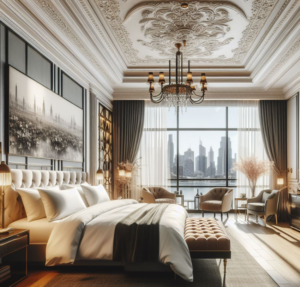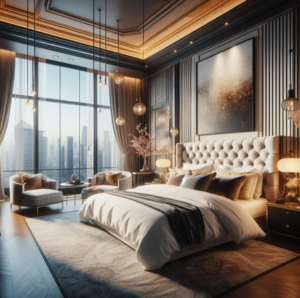 Embracing the boutique hotel bedroom aesthetic involves adopting a design philosophy that centers on creating distinct and immersive environments for guests. This approach departs from the uniformity typically found in chain hotels and emphasizes individuality and local flair. By incorporating elements that reflect regional traditions and history, designers afford travelers more than just a place to rest; they offer an extension of the travel experience itself.
Embracing the boutique hotel bedroom aesthetic involves adopting a design philosophy that centers on creating distinct and immersive environments for guests. This approach departs from the uniformity typically found in chain hotels and emphasizes individuality and local flair. By incorporating elements that reflect regional traditions and history, designers afford travelers more than just a place to rest; they offer an extension of the travel experience itself.
When stepping into a boutique hotel bedroom, one is greeted by an array of textures, colors, and artwork that are carefully selected to tell a story. Designers seek out one-of-a-kind pieces, from handwoven textiles to artisan-crafted furniture, thereby anchoring each room in its specific context. The personal touch in these spaces extends beyond mere aesthetics; it fosters an emotional connection, turning an ordinary stay into a memorable chapter in a guest’s journey.
The unique ambiance of boutique hotel bedrooms lies in the details. The use of reclaimed materials, such as wood or metal, brings an eco-conscious and authentic dimension to the room. The walls may feature commissioned murals or photography from local artists, reinforcing the hotel’s connection with the community and offering guests a deeper understanding of their destination.
Lighting plays an important role as well, with bespoke fixtures serving as focal points that enhance the overall decor. Textiles are selected with care, often highlighting traditional patterns, to ensure warmth and comfort. This is complemented by a deliberate approach to color palettes, which aim to evoke certain emotions and contribute to the story each room seeks to convey.
Attention to comfort also sets these bedrooms apart. Fine linens, plush pillows, and top-tier mattresses are staples, ensuring that aesthetic appeal does not come at the expense of a good night’s sleep. Technology is seamlessly integrated to offer convenience without detracting from the room’s character, whether for climate control or entertainment purposes.
In cultivating a boutique hotel bedroom aesthetic, the focus on sustainability is becoming increasingly prominent. Designers opt for materials and practices that minimize environmental impact, reflecting the growing preference among travelers for eco-friendly accommodations. This might include sourcing locally to reduce carbon footprints or using recycled materials in design elements.
The boutique bedroom’s allure lies in the thoughtful balance between showcasing the locale’s spirit and providing a sanctuary for relaxation and rejuvenation. Each aspect of design aims to enhance the guest experience, ensuring that each stay is as delightful as it is distinctive. With every detail, from custom furniture to artisanal decor, contributing to a space that is both reflective of place and conducive to comfort, the boutique hotel bedroom stands as an inspiring example of modern hospitality design.
Sustainable Luxury in Modern Lodgings
Sustainable luxury in modern lodgings aligns with today’s increasing environmental awareness. As ecological concerns become more pressing, the hospitality industry is embracing a new paradigm that integrates luxury with sustainability. Boutique hotel bedrooms serve as prime examples of this trend.
The design of boutique hotels has evolved to integrate environmentally responsible practices that maintain a high level of elegance and comfort. This transformation is evident in the strategic selection of materials and an approach to energy consumption that aligns with ecological priorities. Recycled materials are being used extensively in construction and finishing, ensuring that the environmental impact of the hotels is kept to a minimum. These materials are chosen for their unique aesthetic appeal, introducing an element of rustic charm or industrial chic to the lodging experience.
The use of non-toxic paints is another aspect of the sustainable shift in the lodging industry. These paints contribute to better indoor air quality and minimize the potential health hazards associated with volatile organic compounds commonly found in traditional paints. This creates a safer and more pleasant environment for guests and staff alike.
Energy conservation efforts are displayed through the investment in energy-efficient lighting. LED technology, for instance, significantly reduces electricity consumption while providing a serene ambiance that complements the ethos of luxury accommodations. Similarly, climate control systems are designed to be efficient and responsive, reducing energy waste without sacrificing guest comfort.
Organic linens and natural fiber rugs offer guests the plush comfort expected from high-end establishments while being produced in an environmentally responsible manner. The textiles are sourced from suppliers who practice sustainable farming, ensuring that the input materials are renewable and that their production processes have a lower environmental footprint.
The furniture selection in these boutique hotel bedrooms underscores a commitment to ethical sourcing. Pieces are frequently acquired from producers who are certified for their sustainable practices, such as using reclaimed wood or adhering to fair trade principles. This careful curation of furnishings supports the communities involved in the production process.
When it comes to aesthetics, modern luxury lodgings are embracing the minimalist design philosophy that embodies elegance through simplicity. Clean lines and neutral palettes define the spaces that promote a sense of calm and well-being. Despite the minimalist approach, designers are intent on creating spaces that are warm and inviting. They achieve this through the introduction of vibrant artwork or decorative elements with intricate patterns that provide visual interest and cultural richness to the room’s design narrative.
This transformation of luxury lodgings into sustainable sanctuaries reflects an important shift in consumer values and industry standards. The successful marriage of luxurious experiences with eco-consciousness demonstrates the industry’s adaptability and redefines what it means to stay in a high-end hotel, with a reduced footprint on the natural world.
Reviving Historical Elements with Contemporary Flair
 The intersection of historical appreciation and modern design is increasingly evident in boutique hotel bedroom decor. The fusion of past elegance with present-day sophistication offers travelers a unique stay, where the story of the building enriches their experience. Architects and designers are becoming more skilled at preserving the integrity of historic buildings while integrating the convenience and luxury of modern features.
The intersection of historical appreciation and modern design is increasingly evident in boutique hotel bedroom decor. The fusion of past elegance with present-day sophistication offers travelers a unique stay, where the story of the building enriches their experience. Architects and designers are becoming more skilled at preserving the integrity of historic buildings while integrating the convenience and luxury of modern features.
As travelers increasingly seek accommodations that offer a narrative along with comfort, hotels housed in repurposed historic buildings meet this demand with creativity. These structures are undergoing careful transformation, with an emphasis on retaining the charm and character of their original purposes. For example, industrial-era looms and machinery may be retained in a textile mill-turned-lodging, repurposed as art pieces or functional components of the decor. Similarly, a former bank might retain its grand vault doors, repurposed as entrances to private dining rooms or meeting spaces.
Inside boutique hotel bedrooms, this trend manifests through a delicate balance between conservation and innovation. The authenticity of the historical elements, such as ornate moldings, high ceilings, and original fireplaces is maintained. They act as focal points in rooms now equipped with high-speed Wi-Fi, plush bedding, and sleek bathroom fixtures. The juxtaposition of period details with contemporary flair offers an enriched experience, celebrating the building’s past while providing all the necessities of modern comfort.
The modern amenities do more than just augment the guest’s stay; they ensure practicality without detracting from the building’s narrative. Climate control is embedded within these historical contexts, offering guests year-round comfort, advanced lighting systems highlight architectural features without compromising their integrity, and soundproofing is added to ensure a tranquil urban retreat.
Each space is thoughtfully designed to serve as a testament to both the history it embodies and the present moment it serves. The designs are carefully curated, reflecting an aura of authenticity and character. Whether a traveler is staying in a room that once served as a turn-of-the-century hospital ward or a mid-century corporate office, the experience is immersive and comprehensive.
Each element of the design contributes to an overarching sense of place, making boutique hotels destinations in their own right. By honoring the past and embracing the future, these hotels provide a unique service. They offer not just a place to rest, but a moment of connection to the tapestry of the locale’s history, creating a memorable stay that is much more than the sum of its parts. Boutique hotel bedrooms thus stand out as exemplars of how design can create distinct, engaging spaces that resonate with guests on a deeply individual level.
















